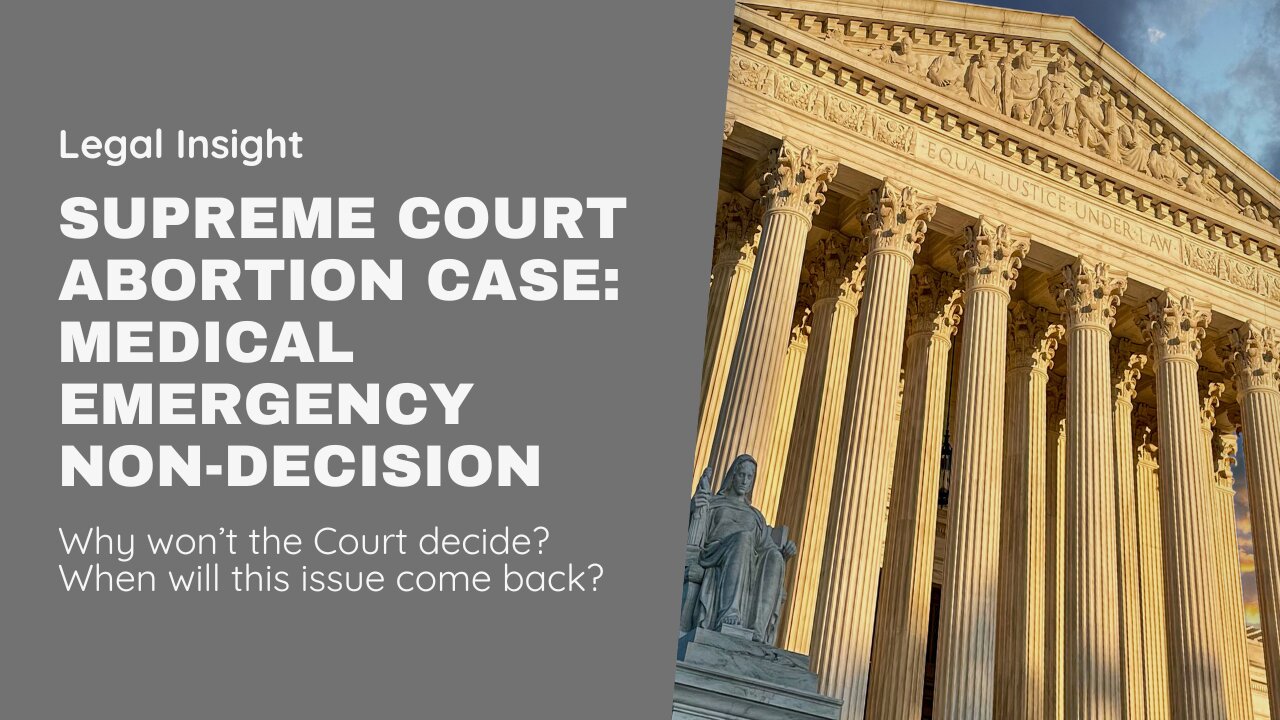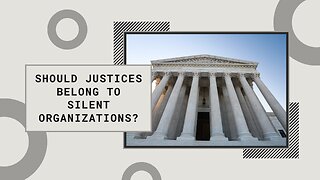Premium Only Content

Idaho abortion case punted
Idaho abortion case punted
By Terry A. Hurlbut
Today the Supreme Court released an opinion in two consolidated cases out of Idaho having to do with abortion. At issue: whether the Emergency Medical Treatment And Labor Act (EMTALA) ever requires abortion, and if so, when. A federal district judge in Idaho, saying Yes, enjoined enforcement of Idaho’s law forbidding abortions. Or rather: he enjoined the law as it applied to women presenting in a hospital emergency room with “high-risk” pregnancies. The Ninth Circuit – after hearing the case en banc – affirmed the injunction. The Supreme Court stayed the injunction on January 5, then granted full review before judgment. Today the Court dismissed the review petitions as “improvidently granted,” and vacated the stay of injunction. From the opinion, the Liberals and the Originalists voted in their usual way – and the Moderates “split the baby.” As a result, no one is happy.
Review of the Idaho abortion cases
The cases are called Moyle v. United States (23-726) and Idaho v. United States (23-727). The “Moyle” here is Rep. Mike Moyle (R-Star, Idaho), Speaker of the Idaho House.
Idaho has no fewer than four “abortion tourist trap” States bordering it – but stubbornly insists that abortion is wrong. That State passed its Defense of Life Act, Idaho Code Section 18-622, while the Dobbs case, “the case that overturned Roe,” was working its way to the Supreme Court. Dobbs v. Jackson Women’s Health Organization, 597 U.S. 215 (2022). Two years ago yesterday, the Supreme Court handed down its 6-3 decision that abortion should not be a federal matter.
The Biden Administration will see no abortion unperformed. So they sued the State in the U.S. District Court for the District of Idaho. U.S. v. Idaho, 1:22-cv-00329, Barry Lynn Winmill presiding. The government alleged that Section 622 conflicted directly with the Federal Emergency Medical Treatment And Labor Act (EMTALA). In their complaint, the government essentially said that, without abortion available as an option, women would die in emergency rooms.
At issue before the Court was:
1. Does EMTALA ever require abortion as “the only stabilizing treatment”?
2. Does the law actually forbid abortions, regardless of any medical emergency?
For further historical details, see here. More to the point, the case came to oral argument on April 25. Elizabeth B. Prelogar, Solicitor General, argued the government’s case. She made one thing abundantly clear: she wants the freedom to get an abortion. Anytime, anywhere.
The Supreme Court punts the case
In a terse per curiam order, the Court dismissed the review petitions in the consolidated cases, and vacated all stays. That means the preliminary injunction by Judge Winmill goes back into effect. So why does this “slip opinion” run to 48 pages? Because 47 pages include two full concurrences, one partial dissent, and one complete dissent.
From the concurrences, dissents, and the names of the Justices writing or joining each, one may infer that:
• Chief Justice John Roberts and Justices Amy Coney Barrett, Brett Kavanaugh, Ketanji Brown Jackson, Elena Kagan, and Sonia Sotomayor voted for the vacaturs, and
• Justices Sam Alito, Neil Gorsuch, and Clarence Thomas voted against.
In short, this is a Moderates’ decision, as CNAV predicted earlier this week. The Liberals went along for expedience’ sake (though Justice Jackson vehemently lamented the lack of a decisive blow for abortion). For their part, the Originalists stood on Idaho’s reading of EMTALA, which is different from everyone else’s.
The opinion document contains four opinions, appearing in this order:
1. Concurrence by Justice Kagan, in which Justice Sotomayor joins completely, and Justice Jackson joins in part,
2. Concurrence by Justice Barrett, in which Chief Justice Roberts and Justice Kavanaugh join,
3. Dissent by Justice Jackson, saying the Court should have struck down Idaho’s law forthwith, and
4. Dissent by Justice Alito, in which Justice Thomas joins fully and Justice Gorsuch joins in part.
Substance of the opinions
Actually, the Clerk of the Court would have done better to put Justice Barrett’s concurrence first. It gives the closest to a logical explanation for summarily dismissing the case. In fact, this should have been the Opinion of the Court, except that the Moderate and Liberal Blocs differed 3-3 in their reasoning. Because an irreconcilable tie existed, the Court delivered an unsigned order. Therefore CNAV will take up Barrett’s concurrence first.
Barrett concludes that, since Rep. Moyle and the State of Idaho applied separately for a stay of the injunction, circumstances have changed. The changes consist, she asserts, of amendments to the Defense of Life Act to address, for example, the fear that it forbade removal of ectopic or molar pregnancies. Furthermore the Idaho Supreme Court, after Judge Winmill handed down his injunction, construed the Act to allow for abortions in the dire cases the government mentioned. In addition to ectopic pregnancies, they included:
• Toxemia of pregnancy, with or without seizures, once known as pre-eclampsia and eclampsia,
• Pre-term premature rupture of membranes (meaning if “the waters break” earlier than the 37th week),
• Sepsis, and
• Abruptio placentae, in which the placenta tears itself away from the wall of the womb.
But Barrett also includes this key observation: that the federal government issued a new guidance on EMTALA. Quoting from the opinion:
If [physicians] believe that “abortion is the stabilizing treatment necessary to resolve” a pregnant woman’s emergency medical condition, they “must provide that treatment.” Id., at 1 (italics and emphasis deleted). Any contrary state law, the guidance continues, is “preempted.” Ibid. (italics and emphasis deleted).
Assumption: the law forbids abortion even in cases of ectopic pregnancy
Judge Winmill granted his injunction, says Barrett, on three assumptions:
1. The Defense of Life Act (as then written?) forbids removing an ectopic pregnancy,
2. The woman would “imminently” or “certainly” die without an abortion, and
3. Any necessity to prevent the death of the mother would only be an affirmative defense at trial.
Shortly thereafter the Idaho Supreme Court, in a separate case, invalidated all three assumptions. Planned Parenthood of the Greater Northwest v. State of Idaho, 171 Idaho 374, 445, 522 P. 3d 1132, 1203 (2023). No matter, said Judge Winmill; the injunction remains in effect. This next part is key: Idaho’s legislature went back and changed their law to reflect the Idaho Supreme Court’s construction.
Barrett then asserts that, after briefing and argument, the two parties turned out to be closer together than they appeared. The key sticking point was whether a mental health exception existed. Solicitor General Prelogar insisted that it did not, and Barrett seems to have accepted that notion uncritically. Again, quoting her opinion:
At the merits stage, however, the United States disclaimed these interpretations of EMTALA. First, it emphatically disavowed the notion that an abortion is ever required as stabilizing treatment for mental health conditions. Brief for United States 26, n. 5; Tr. of Oral Arg. 76–78. That is an important concession: If restricted to conditions posing serious jeopardy to a woman’s physical health, the Government’s reading of EMTALA does not gut Idaho’s Act.* Second, the United States clarified that federal conscience protections, for both hospitals and individual physicians, apply in the EMTALA context. Tr. of Oral Arg. 87–89. That is another critical point: It alleviates Idaho’s concern that the Government’s interpretation of EMTALA would strip healthcare providers of conscience protections.
And here is the asterisked footnote:
The United States also clarified that if pregnancy seriously jeopardizes the woman’s health postviability, EMTALA requires delivery, not abortion. Brief for United States 10; Tr. of Oral Arg. 75. And it emphasized that EMTALA requires abortion only in an “emergency acute medical situation,” where a woman’s health is in jeopardy if she does not receive an abortion “then and there.” Tr. of Oral Arg. 79–80. These two temporal points also narrow the scope of EMTALA’s potential conflict with Idaho’s Act.
Barrett also observed that petitioner’s counsel said Idaho would not prosecute doctors who performed abortions in the Four Hurry Cases. Given these things, says Barrett, what is either side worried about? She also wished to let the Ninth Circuit decide, at their oral argument, whether Congress may, through any Spending Clause statute, compel recipients of federal funds to violate State law as a condition of such funding.
Justice Alito’s dissent
Justice Alito did not agree. He rejected out-of-hand the interpretation of EMTALA that Barrett has seen fit to accept. Indeed he flat-out accused the Biden administration of looking for “ways to limit [the] reach” of his landmark anti-abortion decision. The idea that EMTALA requires all Medicare-funded hospitals to perform abortions under any circumstances strikes him as “novel.”
Clearly he reads the text differently from Justice Barrett – and from Judge Winmill back in Idaho. Both the woman and the unborn child rate due consideration in his view. But he also – within the limits of Justicial etiquette, for which he is a stickler – accused his colleagues of cowardice.
Apparently, the Court has simply lost the will to decide the easy but emotional and highly politicized question that the case presents. That is regrettable.
He could not have rebuked his colleagues any more severely even by saying The Word.
What follows that provocative statement, is, first, a detailed treatment of the statutory text. Nowhere in that text does the word abortion appear. Furthermore, a woman may refuse treatment but may not demand an abortion, if that violates State law. Next, Alito treats the political climate during the Reagan Administration, and the real reason for EMTALA: to stop the “dumping” of charity patients by fee-requiring hospitals when a transfer would make their clinical problems worse. In the debate on EMTALA, several Reagan administration officials assured people that EMTALA would not require abortion under any circumstances.
Beyond that, Alito observes that Spending Clause legislation, like EMTALA, cannot bind anyone to conditions they never accepted. This rule applies to the State of Idaho, which desires to ban elective abortion.
Idaho does have to worry about whether its abortion law is enforceable
In criticizing the vacatur of the stay of injunction, Alito rejects the notion that the Defense of Life Act remains enforceable apart from emergency cases. He finds it absurd to suggest, as Barrett does, that the two sides are closer together than they thought. And he accepts Idaho’s fear of a federal mental-health exception – based on a statement by the American Psychiatric Association.
Freedom to act to interrupt pregnancy must be considered a mental health imperative with major social and mental health implications.
That comes from a 2023 APA position paper. Furthermore, Alito cites Doe v. Bolton, the companion case to Roe v. Wade. That case specifically allowed for a mental-health ground for abortion, even in the third trimester. For that reason, jurists always understood the United States to permit abortion on demand, for any reason or no reason.
The Liberal Concurrence – and Dissent
The Liberal Bloc opinion came from Justice Kagan, who accepted uncritically the:
• Government’s interpretation of EMTALA, and
• Assurances that EMTALA would not open the gate for elective abortions.
She also rounded on Justice Alito, asking him how he dared “dispute … medical fact.” From her opinion:
EMTALA unambiguously requires that a Medicare-funded hospital provide whatever medical treatment is necessary to stabilize a health emergency—and an abortion, in rare situations, is such a treatment.
She arrives at that conclusion only indirectly, by observing that EMTALA never enumerates other stabilizing treatments. That “abortion, in rare situations, is such a treatment” is only an inference from prevailing medical opinion. Therein lies her greatest weakness: she accepts prevailing medical opinion as indisputable fact.
Justice Jackson dissents from one part of the result: dismissing the writ of review. (So the vote was actually 5-4 to dismiss the writ, but 6-3 to vacate the stay of injunction.) She wanted the Court to rule definitively that EMTALA does mandate abortion. She didn’t get that result – and she threw a Jacksonian tantrum as a result.
Liberty One News reported yesterday that someone – presumably on the Supreme Court Clerk’s staff – inadvertently released this decision yesterday. However that happened, Clerk’s staff promptly removed it – but not before Bloomberg Law obtained a copy. Liberty One quoted NBC News as repeating a quote by Justice Jackson at the end of her dissent:
Today’s decision is not a victory for pregnant patients in Idaho. It is delay. While this Court dawdles and the country waits, pregnant people experiencing emergency medical conditions remain in a precarious position, as their doctors are kept in the dark about what the law requires. This Court had a chance to bring clarity and certainty to this tragic situation, and we have squandered it. And for as long as we refuse to declare what the law requires, pregnant patients in Idaho, Texas, and elsewhere will be paying the price. Because we owe them—and the Nation—an answer to the straightforward preemption question presented in these cases, I respectfully dissent.
Note carefully: another case on point is making its way through Texas courts, and presumably the Fifth Circuit Court of Appeals. That is likely to produce a split in the circuits, and then the Court will have to act definitively.
Abortion is definitely an election issue
The outcome today definitely makes abortion an issue in the Election of 2024, for two reasons. First, a second Trump administration could reverse the guidance by the Centers for Medicare and Medicaid Services regarding EMTALA requirements. Trump’s ordering this would be consistent with his declaration of leaving abortion to the States. (That guidance demonstrably violates States’ rights, as the Liberal Bloc wants.) Second, Sonia Sotomayor, requiring as she does a doctor to attend her in her travels, might not last Trump’s term. Therefore – as many leftists worry – Trump will replace her.
Justice Alito is right: the Moderate Bloc has turned cowardly. The relative youth of Justices Barrett and Kavanaugh – and Barrett being a mother of seven children, five biological and two adopted – makes them vulnerable to blackmail. Kavanaugh in fact has been a direct target of Justicial assassination. As may be, this is the second case this Term that the Court, per the Moderate Bloc, has punted. (The first was Murthy v. Missouri, decided yesterday.)
CNAV pointed out, after the argument, the salient weakness of Supreme Courts everywhere. They rely on lower courts to develop trial records, and have no investigative powers of their own. But they also rely on expert testimony, or rarely on Special Masters. And they can often appoint the wrong Special Masters. Or, as in this case, they accept uncritically the consensus position of a scientific establishment that suffers from ideological corruption.
The medical establishment and its abortion problem
Too many clinical practitioners look upon non-practitioners as “blobs of humanity.” As Luke of Antioch, Patron Saint of Physicians, might have observed, such hubris is most dangerous in the healing arts. Therefore the conservative – and especially the Christian – community needs its own alternative medical academy and establishment. Idaho, in particular, has one medical school (at the University of Idaho, Moscow, Idaho). It could use another – at any of several Christian colleges and universities in Idaho.
The value of – and need for – a Christian medical network makes itself manifest in the opinions released today. If Justices of the Supreme Court will accept uncritically the arrogant proposition that terminating a pregnancy is the definitive, don’t-ask-questions solution for toxemia of pregnancy, for example, then this country has a very serious clinical, scientific – and spiritual – problem. Experts can be and have been wrong.
Our society faces momentous decisions – decisions about the right to die, about abortion, terminal illness, prolonged coma, transplantation – decisions about life and death. But society isn’t deciding. Congress isn’t deciding; the courts aren’t deciding; religion isn’t deciding. Why? Because society is leaving it up to us – the experts – the doctors…. Americans believe in medical care. These great hospital complexes are the cathedrals of our modern age.
Actor Richard Widmark, as George A. Harris, M.D., in Coma (1978)
When he spoke those lines, Richard Widmark convicted Americans of violating the First Commandment.
You shall have no other gods before Me.
Exodus 20:3
But Americans have taken a god ahead of the God of Abraham, Isaac and Jacob – a nondescript, blank-faced god in a white smock. Decisions – or non-decisions – like today’s are the result. Maybe if we start educating humble doctors, who respect the lives of the smallest and most vulnerable among us, America will come to a better place than the Supreme Court showed it to be in today.
Link to:
The article:
https://cnav.news/2024/06/27/news/idaho-abortion-case-punted/
The order, concurrences, and dissents:
https://www.supremecourt.gov/opinions/23pdf/23-726_6jgm.pdf
Interactive abortion law map:
https://www.nbcnews.com/data-graphics/abortion-state-tracking-trigger-laws-bans-restrictions-rcna36199
Position paper of the American Psychiatric Association:
https://www.psychiatry.org/getattachment/2f2371ac-307e-4889-bdb2-f9bf0a12d401/Position-Abortion-Reproductive-Rights.pdf
Declarations of Truth X feed:
https://x.com/DecTruth
Declarations of Truth Locals Community:
https://declarationsoftruth.locals.com/
Conservative News and Views:
https://cnav.news/
Clixnet Media
https://clixnet.com/
-
 20:36
20:36
Declarations of Truth
1 month agoRoberts CJ in a judicial silent organization?
227 -
 2:12:29
2:12:29
Badlands Media
17 hours agoDevolution Power Hour Ep. 355: Prom Kings, Puppet Courts, and the Shadow Presidency
149K50 -
 2:05:24
2:05:24
Tundra Tactical
11 hours ago $35.61 earned🛑LIVE NOW!!!! GOP Tanks Guns Rights In Their One Big Beautiful Bill🛑
111K37 -
 19:09
19:09
Forrest Galante
10 hours agoPrivate Tour of Florida's WILDEST Backyard Zoo
47K6 -
 3:18:12
3:18:12
BlackDiamondGunsandGear
1 day ago🔴 Top 5 Guns u NEED to be a "GUN GUY" / with DLD & Fit-N-Fire
61.2K7 -
 3:18:12
3:18:12
DLDAfterDark
10 hours ago $3.75 earnedDLD Live! What Are Your Top 5 Guns??
34.6K3 -
 3:10:03
3:10:03
Mally_Mouse
14 hours agoSpicy Saturday!! - Let's Play: Lockdown Protocol w/Friends!
395K11 -
 LIVE
LIVE
Major League Fishing
3 days agoLIVE! - Bass Pro Tour: Heavy Hitters - Day 1
1,545 watching -
 8:00:02
8:00:02
SpartakusLIVE
14 hours agoWZ Solos || #1 Challenge MASTER brings you Saturday SPARTOONS
66.2K1 -
 9:05:51
9:05:51
Spartan (Pro Halo esports Player)
16 hours agoNo Scrims today so Ranked for a bit then SWTOR
54.6K2